[Report]
Seeing Sound Symposium 2013
Seeing Sound Symposium 2013
23–24 November 2013
Bath Spa, UK: Bath Spa University
http://seeingsound.co.uk
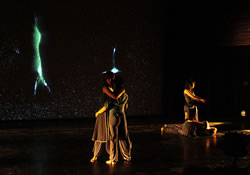
The third Seeing Sound symposium, held at Bath Spa University (UK) took place over two days in late November 2013. It comprised an international gathering of established and emerging researchers and practitioners in the area of sound and image who presented papers and works, and also included live concerts on each evening of the symposium in the University Theatre. Seeing Sound 2013 was a significantly bigger event in comparison to previous years, with twenty-two papers presented over four parallel sessions, one keynote paper, twenty-five fixed media screenings presented over three screening concerts and ten live performances. There was a larger attendance at the symposium, with delegates coming from Spain, Ireland, Germany, France, the Netherlands, the US, Canada, Japan, Venezuela, Brazil and Australia, and there were packed audiences for the two live concert performances, which were also open to the public. The biennial symposium is organised by Professor Joseph Hyde and staff from the School of Music and Performing Arts and staff from the School of Humanities and Cultural Industries at Bath Spa University. It focuses on practice-led research and practice on multimedia work which foregrounds the relationship between sound and image, and therefore covers areas such as visual music, audiovisual performance and installation, abstract cinema and experimental animation.
This year’s event had four broad highlights and themes running through it: 1) the work and legacy of John and James Whitney; 2) live audiovisual performance, including two major innovative dance works; 3) papers which focused on practice-led research and theoretical ideas — many of these authors also presented creative works in the fixed media screening or performed their pieces live in concerts, which offered the public a great opportunity to hear about research and then to actually see and hear the creative outputs of such research; 4) the fixed media screening programmes which included both visual music works and abstract cinema works from established artists and composers in the field as well as from newly emerging artists. Thus the call for works and the curation by the symposium team brought together some very innovative and stunning new audiovisual works.
The Work and Legacy of John and James Whitney
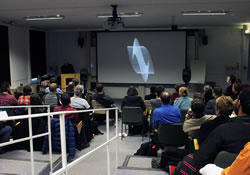
The historical work and contemporary legacy of John and James Whitney was represented through a range of events. There was a screening programme of seven of their works (three of which were in high quality HD digital formats), and the keynote address “Generative Animation, A Personal History” by Larry Cuba, who worked with John Whitney but who also is a computer animation pioneer in his own right, was a highlight of the symposium. Larry gave an account of his work in early computer programming and animation, providing an insight into his determination to work with the best possible computers both to assist John Whitney in his films and to create his own films of which are important works in this field of practice. There were papers also that presented discursive and theoretical analysis of John Whitney’s work and others that referenced their work, such as Richard Stamp’s “The Computer Artist as Media Archaeologist: John Whitney’s ‘gadgeteering’” and Dr. Aimee Mollaghan’s “Between the Binary And Baroque: John Whitney’s search for “a new language for a new art.’” Several visual music works were presented which have followed on from the legacy of John Whitney, such as Bill Alves’ Static Cling, which explores the emergence of resonant patterns in both visual and sound and is influenced by harmonies and visual designs arising from Pythagorean relationships. Lewis Skyes’ live performance work adapts John Whitney’s algorithms to generate stunning “what you hear is what you see” visual patterns used in the visuals for his work presented at one of the live performance concerts.
Live Audiovisual Performance Work
There was an extensive performance programme, with ten live audiovisual performance works, performed over two concerts showcasing cutting edge work by mainly UK-based contemporary artists and live audiovisual performers. There were exciting performances by Bath Spa’s own Behaviour ensemble, a live electroacoustic improvisation ensemble in collaboration with visual artist Jon Piggott. The piece Feeding You, by Disruptive Technologies (Max Hattler [visuals] and Matthias Kispert [audio]) explores an audio-visual language of branding and advertising of global corporations, utilising them as source material but making a bold audiovisual statement on these recognisable colours and brands. The beautiful, ephemeral imagery of UK-based Japanese audiovisual performance artist Ryo Ikeshiro’s Construction in Kneading was based on a live audiovisualisation of a Mandelbrot fractal. The recursion formula resembles the actions of kneading dough in bread-making, and the complex patterns created in the performance are generated from live generated audio and visuals implemented in the Max/MSP/Jitter programming environment. Ikeshiro also presented a paper on “Audiovisualisation” in which he discussed the æsthetic implications of his approach to audiovisualisation in his creative work.
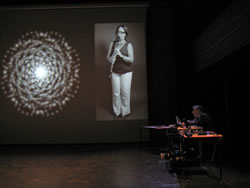
Lewis Sykes’ live performance work The Augmented Tonoscope, Selected Works adapts an algorithm developed by John Whitney Sr. to create dynamic visual patterns, equivalent to the harmonies within the music itself, one such work where there is an incredible synergy between vibratory visual patterns and the tones and timbres of the music. Sykes also presented a paper on his research work and practice, “The Augmented Tonoscope — Musical Interface and Composition.” Paul Prudence, an audio-visual performer and live cinema artist who works with computational and generative audiovisual environments, performed his work Cyclotone, a precisely synchronised, generative and synthesised video with original sound design. Laura Steenberge, who is pursuing a doctorate in music composition at Stanford University, performed an innovative lecture and demonstration on musical form. Her demonstration consisted of a live preparation of balloon and paper cut-out, which eventually floated above the audience giving an uncanny presence as it also demonstrated Laura’s idea that the balloon-object represents the form of the music. Laura also presented a co-prepared paper with Jaroslaw Kapuscinski on “Error in Metaphor: Image as music in 6 intermedia compositions,” teasing out the metaphorical relationships between moving image and music in contemporary practice.
Thor Magnusson, who also presented a paper, performed a live coding audiovisual performance, improvising on his new compositional system, the Threnoscope. The music consisted of drones and microtonality and the visuals focused on representing harmonic relationships, tuning systems and drone states. The video projection consisted of a split screen, one where the slowly evolving visuals changed as the coding was written live and presented on the right side of the screen, thus seeing and hearing audiovisual changes in response to coding changes. Australian based Andy Thomas performed Echoes, which consisted of pre-prepared footage of audio waveform-triggered 3D animated fluid simulations, mixed live to create a sound art performance.
Live Audiovisual Dance Performances
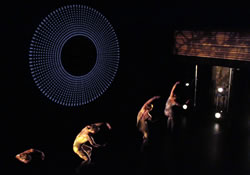
Two of the live audiovisual performances were dance pieces. Unfold to Centre, a dance and visual music work, consisted of a brand new collaboration between computer animation pioneer Larry Cuba and choreographer Yolande Yorke-Edgell. The other dance piece was the award-winning digital dance performance Hidden Fields, which combined cutting edge computing and quantum mechanics with stunning visualisation / sonification and contemporary dance. This piece was a unique collaboration between research scientist David Glowacki, visual artist Phill Tew, computer scientist Thomas Mitchell, composer Joseph Hyde (organiser of the symposium), choreographer Laura Kriefman and contemporary dancers Mikayo Asano, Emma Harrie, Tomomi Kosano and Lisa May Thomas. In “Designing Audio Interaction Within the Danceroom Spectroscopy Quantum Mechanics Simulation and ‘Hidden Fields’ Performance,” Thomas Mitchell presented a paper explaining the role of designing the interaction of the music and audio in such a highly collaborative work.
Practice-Led Research Papers
Much of the research in this area of the interrelationship between sound and image is taking place by music composers, visual music artists, sound artists and video and animation artists, performance artists actively involved in both research and practice. This was reflected in many of the practice-led papers presented at the symposium. Practice-led research addressed a range of historical, theoretical and methodical issues that inform the authors’ present work and approaches to forging relationships between sound and image. Historical perspectives in the field were discussed in several papers. Maura McDonnell’s “Visual Music — The Colour Tone Analogy and Beyond” examines the origins of visual music, while Joe Osmond’s “The Colour of Silence” discusses ideas of silence in the context of historical references. Tom Richard’s “Toward Mini-Oramics” compares contemporary developments in music technology with the important impact of Daphne Oram’s (1925–2003) Oramics machine. Dr. Aimee Mollaghan and Richard Stamp presented papers on some aspect of John Whitney’s work and legacy as mentioned already above. Andrew Connor’s “Felix the (Electroacoustic) Cat” discusses the idea that the malleable elements of the visual tricks that animated the cartoon character Felix the cat are equivalent to the techniques used in electroacoustic composition, in which the composer can adapt and detach elements of a sound object to fit the needs of the music composition. Rhys Davies paper, “From the Laboratory of Hearing to Man with a Movie Camera: Sound as image in the work of Dziga Vertov” presents some very innovative ideas about Vertov’s approach to sound, in which the viewer accesses their own remembered sound in order to signify these with images.
Some of the paper presentations represented both well-established and emerging theoretical views on the area of sound and image or sound and media. Jean Piché’s “Pitfalls of Togetherness: Hyper-synchronicity as inhibitor for metaphor in visual music” critiques the hyper-synchronous display of audio and visual information in terms of its evolution with the field and technology coining a new term “parametric transduction”, concluding that there is a great deal of possibilities for image and sound with the newer parametric mapping possibilities of today’s technology and that the focus is on finding equivalences between the two media to move beyond the tyranny of synchronisation. Many of the authors of research project papers utilise new terms to describe their particular approach to seeing sound or to describe a system they have developed to explore sound and image. Carol MacGillivray uses the term “diasynchronoscope” to denote a new medium and method for creating screenless, choreographed animated objects. Carol and Bruno Mathez presented their collaborative work on diasynchronoscope projects in their paper “Screams of an Acorn: The Diasynchronoscope and new ideas in the morphology of audiovision.”
Samuel Freeman has coined the term “tildegraph” to explain his approach to sound making and exploring visual representations of sound in programmable environments, he discussed this in his paper “The Tildegraph Concept in Sdfsys.” The Threnoscope, Thor Magnusson’s improvisational system, was discussed in his paper “Tunings and Microtonality with the Threnoscope” and also used in his live performance at the symposium. Already mentioned is Lewis Sykes, who uses the term “augmented tonoscope” to describe his practice and research into developing a deeper understanding of the interplay between sound and image in visual music, while his paper, “The Augmented Tonoscope — Musical Interface and Composition” discusses this research project. Fernando Falci de Souza presented the theoretical concepts underpinning the term “audiovisual atomic correspondence,” in which granular synthesis sound is extended to the visual domain, in his paper “Concepts and Creation of Rain: An audiovisual granular synthesis work.”
Other papers focused on particular approaches taken in the authors’ own research projects. A most exciting and innovative research project — a performance series in which pulse readings are taken from participants which is interpreted and drawn into bespoke soundscape compositions, which have an eerily but fascinating human feel to them — was presented in Michelle Lewis-King’s paper “Touching Sound: Pulse project.” Ireti Olowe’s research and practice explores visual music with an expressive juxtaposition between a fixed film with improvised and processed voice, teasing out how the relationship between the two affects our understanding of music, and was the subject of her paper, “Real-Time Graphic Visualization of Multi-Track Sound.” Silence and atmosphere were other æsthetical approaches taken by researchers. Joe Osmond, in his paper “The Colour of Silence,” discusses compositional possibilities of recognising the art of silence referencing theories from music such as Pierre Boulez’s concept of music as a counterpoint of silence and sound, and the visual harmonic theories of John Whitney. Sound artist and researcher Hali Santamas in “Composing in the ‘New Æsthetics’: Atmosphere as compositional material in audio-photographic art” presented innovative ideas in relation to the relationship between photography and sound, highlighting how using both together can engender a sense of atmosphere based on connections in memory and emotion by the audience. In “Composing With Images,” Dr. Steve Bird provided an overview of other areas and traditions that are important in the field of creative work with images and sound, moving beyond the typical abstract visual music and film-making discussions, such as composing with “real-world” imagery and how they interrelate with the sound. Dr. Jules Rawlinson’s research practice draws on several theoretical influences, such as Smalley, Kandinsky and research into graffiti analysis. His paper “Signature Sound: From Tag to Tone — Graffiti as Graphic Score” explores the design methodology for the analysis of sound and gesture for live electronics and working with graffiti tags and graphic scores.
Fixed Media Audiovisual and Visual Music Screenings
The two fixed media screenings, presented also in the University Theatre venue, included a very cutting edge and exciting programme, comprising contemporary works in a range of styles by established and emerging talents in the field of visual music, video art and audiovisual composition. Several of the pieces were created by authors who composed both the visuals and the music, others were pieces that resulted as a result of a collaboration between music composer or musician and video artist, or from visual music artists who work with a given soundtrack.
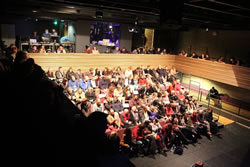
Several works by established artist / composers were also screened during the festival. Bill Alves’ Static Cling (2000) explored Pythagorean relationships designed and composed from a range of chaotic material in visual and music. For Clonal Colonies (2011), Bret Battey generated the music using computer algorithms that were analogously comparable to the visual composition, which emulated the evolution of plants creating interlocked textures and transformations. Jean Piché, who has been active in this field for over forty years, had his reworked piece Heliograms (1970s / 2012) screened, a stunning piece consisting of rhythmic and metallic timbres and textured light and colour. Aaron F. Ross’s Music for a Self-Transforming Machine (2012) explored, in its strong and vivid contrasting colours, a visual and musical space focusing on a recursive sculpture built from fractals, and oscillated between chaos and order. Jon Weinel’s Mezcal Animations (2013) is a recent visual music piece and electroacoustic composition that used a direct animation technique. Robin Price’s Postrush uses the MIDI score and a multi-channel waveform to control the parameters for the creation of a semi-abstract video. Giorgio Magnanensi’s Noisescope, a closely synchronised audio-video work in which there is a close relationship between seeing and listening, was also screened.
Other established and emerging talents in the individual composer / visual artist category were also well represented in the screening programme These included Ghostly (2013) by Maxime Corbeil-Perron, a stop-motion animation film exploring light and shadow, Patrik Lechner’s stunning audiovisual work rt3, which consisted of a recording of an audiovisual improvisation, Andy Dolphin’s reflections, undulations and distortions in Ripple, David McDonald’s fun and tightly audiovisual synchronised Percussion in Colour (2012), based on temporal Gestalt perception in music and its visual representations, as well as two of Clive Walley’s pieces from The Divertimenti (1990s), which consists of a set of films in which each film uses a different composer’s music as the soundtrack and the films visualise the relationship between music and a moving paint æsthetic.
A number of collaborative visual music artists, audiovisual artists and music composers and musicians also had recent works screened. An incessant but subtly evolving and changing beat was explored with visual equivalents in Variegated Beat (2013), by Maura McDonnell (visuals) and Cignol / Sean Reed (music). Machinalement (v32) (2013), by Jean Detheux (visuals) and Jean Derome (music), is a “listening with my eyes” work to the improvisational flute playing by Jean Derome, in which Detheux focuses on the sensitive and elusive space that can exist between the music and the images, not trying at all to mirror the music, but not ignoring it either. Alison Clifford (visuals) and Graeme Truslove’s (music) presented Turbulence (2013), part of a series of works by the two collaborating authors in which ethereal light photographs are reinterpreted visually and in which the music structures the experience of the new visuals. An audio-visual art piece by Nick Cope (visuals) and Tim Howle’s (music), Globus Hystericus, explored acousmatic possibilities in the music extended to incorporate parallel ideas found in video art. Zai Tang (music) and Simon Ball (visuals) collaborated in Exploit (Bukit Brown Cemetery II) (2013, which was based around Tang’s soundscape study of Bukit Brown Cemetery in China. Terroir , by Teresa Connors (music) and Shannon Harris (visuals), is an abstract piece based on footage captured on an old cell phone over two years.
By providing a forum for researchers and practitioners in the fields of audio-visual and visual-music composition to present, discuss and articulate, through papers, screenings and live performances, their works and creative synergies, the symposium gathered together and brought to the fore the rich historical heritage and rapidly evolving nature of this art-form, from the works of John Whitney to the pioneering efforts of Larry Cuba. In doing this, Seeing Sound 2013 certainly lived up to its name.
Social top